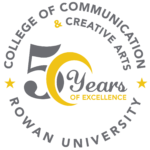A [Brief] 50-Year History
“You can’t know where you’re going unless you know where you’ve been.”
In 2016-2017, Rowan University’s College of Communication & Creative Arts celebrated fifty years of excellence, dating back to the formation of the original Department of Communications in the 1966-1967 academic year. I produced a film that tells the story of the original academic program formation and evolution, as told by some of the “movers and the shakers” and early leaders who helped shape the Communications department and college over the course of a half-century. How do you cram 50 years of history into 20 minutes? A lot of editing. Watch the film by clicking on the logo below… and then read more below that for some behind-the-scenes insight.
Project conceptualization began in mid-2016. At the onset of planning the 50-year event for the College, it was determined that this film would premiere at the celebration banquet on April 1, 2017 (no joke!). The only parameter I was advised to adhere to was a limit for running time – 10 minutes was the suggestion; 15 minutes was my goal for an upper limit. Research and identification of ten key “storytellers” occurred late 2016 / early 2017. Due to my schedule and existing obligations, I was unable to begin active production on the project until January 2017, with interviews shot through early March. The project as premiered on April 1 was complete and clocked in just under 15 minutes; however due to a few storytellers’ schedules and travel arrangements not able to line up conducive for video interviews in the allotted production timeframe, a few stories were absent from that film version. Additional interviews were conducted in April and May, with the complete finished film (as available at the link above) distributed online in June 2017 – just in time to close the 50th academic year for the College.
Nine of the ten originally identified storytellers were interviewed for the film; the tenth was identified as a guest speaker at the banquet event and we determined that person’s commentary “live” would be better than on video. Each interview on its own was approximately 45 minutes in length, with discussion on a variety of subjects to garner multiple viewpoints and “voices” for the story. So yes, I had roughly 7 hours of content to sift through and whittle down to what would become the 20-minute film. The only original non-interview video I shot for this project was the opening and closing scenic shots of the stylized classroom, with the 2016-2017 mission statement of the College written on the whiteboard. All else was archival material.
For further reading, here’s a small FAQ… if you want to know more, contact me!
What was the most difficult part of this project?
Time was not on my side, with a tight timeframe from first shoot to the banquet event. Granted, this was somewhat self-imposed due to my own availability (or lack thereof) to work on the project. Everything was one-man-band style, due to lack of time to train anyone specifically for my needs and lack of budget to effectively pay anyone as a PA (student or professional). The only external assistance I received in production was for the interview shoot which had to occur in Florida – and there was no air travel budget for me! A Rowan RTF alumnus lived only 45 minutes from the location and had his own equipment, enough to do the job for a nominal barter/donation arrangement.
Why was everyone looking at the camera instead of an off-camera interviewer?
This was a style choice I made for two reasons: first, early on there was the potential that some interviews would be conducted online via Skype, iChat, or some other videoconferencing app. I didn’t want those people to look at the camera and have others looking off-camera, so I determined that everyone would look at the camera. Secondly, I wanted this to have the aesthetic of the viewer and the interviewees to be talking with each other – to make it more personal, as would be the approach of this piece – not a facts-and-figures timeline but rather the telling of a story that paints a picture of the history and evolution of the department/college. Each interviewee is telling you their story.
Which interview was most challenging?
There were a few, for various reasons. Logistically, one interview was in someone’s apartment that was on the 3rd floor of a 3-story building at the end of a very long hallway. Thank goodness for the bellhop cart and elevator. Production-wise, one interviewee sat in a rocking chair for the first 10 minutes of the interview, and two minutes in started rocking to ease nervousness. I had to manually pull focus on the lens at a rate to match the back-and-forth rocking. At a convenient stopping point, I swapped chairs. Content-wise, I had sent one interviewee questions ahead of time because it was supposed to be a Skype/iChat interview that couldn’t happen, that then was going to be a self-recorded interview… that also did not occur. By the time I did the sit-down interview, the interviewee had pre-planned all answers and it sounded very scripted. This was not the style I was going for and had to rethink the interview strategy on-the-fly.
What gear did you use?*
Camera: Canon EOS-60D DSLR
Lens: Canon EF 50mm f/1.4 USM
Tripod: Continental DGB-3E with Manfrotto MVH500A fluid drag video head
Primary Mic: Sennheiser ME66/K6P
Audio Recording: Tascam DR-60mkII
Lighting: Lowel Blender LEDs; Lowel DV Creator 55 Kit; Arri 650 & 350 fresnels (studio only)
Post: Adobe Premiere Pro CC 2015; Adobe Photoshop CC 2015
Workflow/Organizational: Google Drive
*This list is provided for informational purposes only and does not constitute a recommendation, rating or endorsement of these products.
